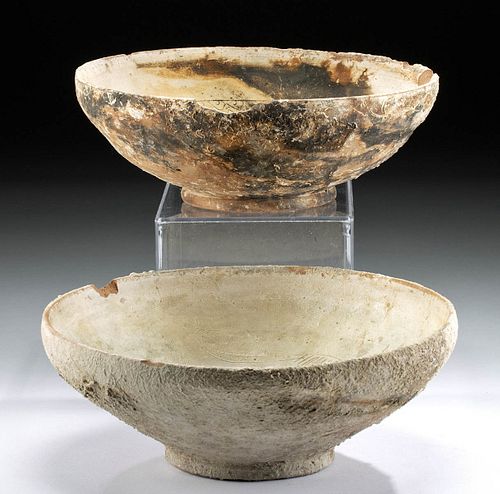2 Late Byzantine Pottery Bowls w/ Sea Encrustations
Lot 33
About Seller
Artemis Fine Arts
686 S Taylor Ave, Ste 106
Louisville, CO 80027
United States
Selling antiquities, ancient and ethnographic art online since 1993, Artemis Gallery specializes in Classical Antiquities (Egyptian, Greek, Roman, Near Eastern), Asian, Pre-Columbian, African / Tribal / Oceanographic art. Our extensive inventory includes pottery, stone, metal, wood, glass and textil...Read more
Categories
Estimate:
$800 - $1,200
Absentee vs Live bid
Two ways to bid:
- Leave a max absentee bid and the platform will bid on your behalf up to your maximum bid during the live auction.
- Bid live during the auction and your bids will be submitted real-time to the auctioneer.
Bid Increments
| Price | Bid Increment |
|---|---|
| $0 | $25 |
| $300 | $50 |
| $1,000 | $100 |
| $2,000 | $250 |
| $5,000 | $500 |
| $10,000 | $1,000 |
| $20,000 | $2,500 |
| $50,000 | $5,000 |
| $100,000 | $10,000 |
| $200,000 | $20,000 |
About Auction
By Artemis Fine Arts
Feb 17, 2022
Set Reminder
2022-02-17 10:00:00
2022-02-17 10:00:00
America/New_York
Bidsquare
Bidsquare : CLEARANCE | Ancient & Ethnographic Art
https://www.bidsquare.com/auctions/artemis-gallery/clearance-ancient-ethnographic-art-8898
Join us for our first clearance sale of the year featuring discounted pricing and many new items! Asian art, Classical antiquities from Egypt, Greece, Italy, and the Near East...plus Pre-Columbian, Tribal, Spanish Colonial, Fine Art, Fossils, more! Artemis Fine Arts info@artemisgallery.com
Join us for our first clearance sale of the year featuring discounted pricing and many new items! Asian art, Classical antiquities from Egypt, Greece, Italy, and the Near East...plus Pre-Columbian, Tribal, Spanish Colonial, Fine Art, Fossils, more! Artemis Fine Arts info@artemisgallery.com
- Lot Description
**First Time At Auction**
Near East / Holy Land, late Byzantine Empire, ca. 13th century CE. A pair of well-preserved pottery bowls with a decorated interior that is incised with linear patterning and a bird. The bowls are similar in shape, both rest on a ring foot and the broad dish flares upward to a thick rim and basin. The first bowl has two narrow bands of repeated triangular motifs encircle the interior body, with an interlocking abstract floral motif in tondo, and the larger bowl has a bird and abstract foliate stems or branches. Remains of a white glaze slip is still present over much of the interior surface of both, a decoration technique called sgraffito, with the design incised through a white slip coating to reveal the red clay body beneath. These bowls were made and exported throughout the Empire, and have been found in numerous shipwrecks, especially in the Aegean Sea, and these two bowls a with marine deposits and creature activity on much of the exterior. Size (bird bowl): 10" W x 3.75" H (25.4 cm x 9.5 cm)
Provenance: East Coast collection, New York Gallery, New York City, New York, USA, acquired before 2010
All items legal to buy/sell under U.S. Statute covering cultural patrimony Code 2600, CHAPTER 14, and are guaranteed to be as described or your money back.
A Certificate of Authenticity will accompany all winning bids.
PLEASE NOTE: Due to recent increases of shipments being seized by Australian & German customs (even for items with pre-UNESCO provenance), we will no longer ship most antiquities and ancient Chinese art to Australia & Germany. For categories of items that are acceptable to ship to Australia or Germany, please contact us directly or work with your local customs brokerage firm.
Display stands not described as included/custom in the item description are for photography purposes only and will not be included with the item upon shipping.
#166071Losses and chips to the rims of both bowls. Surface abrasions and discoloration to both, but motifs are intact and good remains of glazing. Heavy mineral and white buildup and tubes due to sea worm activity indicative of time spent underwater.Condition
- Shipping Info
-
All shipping is handled in-house for your convenience. Your invoice from Artemis Gallery will include shipping calculation instructions. If in doubt, please inquire BEFORE bidding for estimated shipping costs for individual items.
-
- Buyer's Premium



 EUR
EUR CAD
CAD AUD
AUD GBP
GBP MXN
MXN HKD
HKD CNY
CNY MYR
MYR SEK
SEK SGD
SGD CHF
CHF THB
THB















